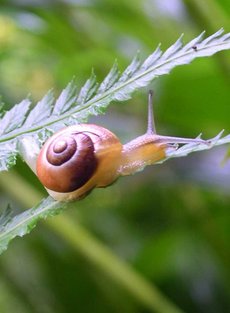Helix (genus)
|
|
| Helix | ||||||||||||
|---|---|---|---|---|---|---|---|---|---|---|---|---|
 Roman snail (Helix pomatia) | ||||||||||||
| Scientific classification | ||||||||||||
| ||||||||||||
| Species | ||||||||||||
|
see text |
The Genus Helix belongs to the Family Helicidae. The most famous species are: Helix aspersa (Brown Garden Snail), Helix pomatia (Roman Snail, Burgundy Snail, and the Edible Snail).
| Contents |
Where snails are naturally found
Snails prefer damp and cool environments, as they easily suffer from moisture loss. Snails are most active during at night and after rainfall. During unfavourable conditions, a snail will remain inside its shell, usually under rocks or other hiding places to avoid being discovered by predators. In dry climates snails will naturally congregate near water sources, including artificial sources such as waste-water outlets of air conditioners.
What snails eat and who eats snails
The common garden snails (Helix aspersa) are herbivores. They are able to digest most of vegetation such as carrots and lettuce. Besides, the specialized gut called crop has symbiotic bacteria that used to digest cellulose.
There are many predators that kill snails. Some animals such as the song thrush break the hard external shell of the snails by hammering the shell on a stone before they eat the snails. Others just start to bite the lip. Some animals such as frogs even eat the shell of the snail.
Many Europeans enjoy eating snails. Helix pomatia is the one of the best known edible snails. In addition to the excellent taste of the snails, they have a lot of nutrients in them. They are very rich in calcium and some vitamin B1 and E. They also supply various kinds of essential amino acid. On the other hand, they are low in food energy and fat.
External features
Common_snail.jpg
In addition to the hard calcareous shell that covers and protects the internal organs, the head and foot region can be observed when the snails are fully extended. When they are active, the organs such as the lung, heart, kidney and intestines remain inside the shell, the head and foot are come out of it.
The front end is the head region where one pair of tentacles and eyes and mouth are located. The tentacles are withdrawn and extended continuously depends on the situation. The mouth has very unique tongue called "redula" that is composed of many fine chitinous teeth. This serves as rasping and cutting food.
The foot plays an important role in moving the body. Mucus secreted by the surface of the foot can be observed behind the traces of the snails.
Mating
From April throughout the summer, the snail’s copulation is flourishing because high temperature and high humidity enhances the possibility of oviposition. The Pulmonate snails are hermaphrodite, meaning that both female and male sexual organs are present in the same individual. The snails produce both eggs and sperm in the ovotetis called the hermaphrodite gland, but it is later separated into two divisions, a sperm duct and oviduct, respectively.
Mating takes several hours, sometimes a day. A few days later, the eggs are laid in the soil. They are usually 4-6 mm in diameter.
Growth and Death
After snails are hatched from the egg, they mature through one or more years. It depends on where the organism lives. Maturity takes two years in Southern California, while it takes only ten months in South Africa.
The size of the adult snails slightly varies with species. H. aspersa grows up to 35mm in height and width, whereas H. pomatia grows up to 45mm. The life span of the snails is average two or three years.
Some snails many live longer, but no more than eight years. Many deaths are due to predators and parasites.
Respiration
The snail in the Genus Helix lives in terrestrial environment rather than in fresh water and marine, they have developed a simple lung. Other snails that belong to the Class Gastropoda have gills instead.
Oxygen is carried by the blood pigment, haemocyanin. Both oxygen and carbon dioxide diffuse in and out of blood through the capillaries. A muscular valve regulates the process of opening and closing the entrance of the lung. When the valve opens, the air can either leave or come into the lung. The valve plays an important role in reducing water loss.
Taxonomy
- Helix aperta Born, 1778
- Helix aspersa Műller, 1774 Brown Garden Snail, Common Garden Snail
- Helix engaddenis Bourguinat, 1852
- Helix lucorum Linnaeus, 1758
- Helix melanostomata Draparnaud, 1801
- Helix pomatia Linnaeus, 1758: Burgundy Snail, Roman Snail, Edible Snail
- Helix vermiculata
External link
- Garden Snail (http://www.arkive.org/species/ARK/invertebrates_terrestrial_and_freshwater/Helix_aspersa/more_info.html)
